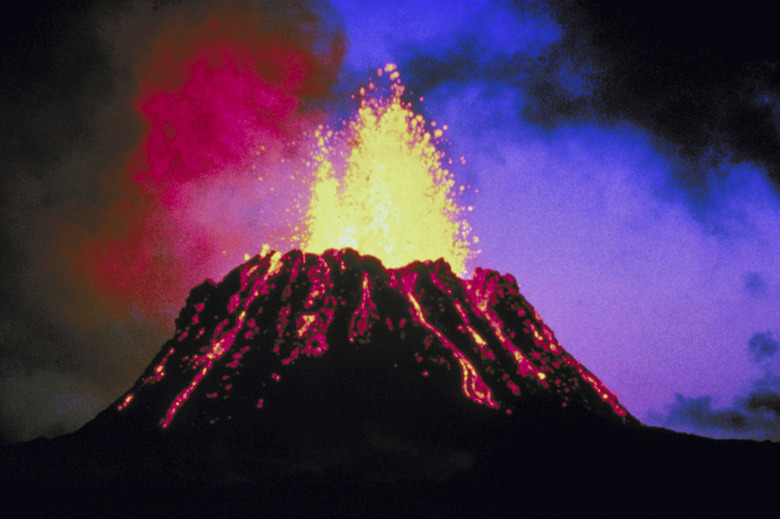What Best Describes The Relationship Between Earth's Crust & The Lithosphere?
Geologists study and work to better understand the Earth, including the many layers of stone and magma beneath your feet. The relationship between Earth's crust and the lithosphere can best be described as cohesive.
The crust is the outermost layer of the planet, and the lithosphere includes both the crust and the solid upper portion of Earth's mantle. Activity in the lithosphere often results in changes to the Earth's crust.
What Is the Earth's Crust?
What Is the Earth's Crust?
The Earth's crust consists of the uppermost layer of rock. It is what makes up the ground that you walk on, and extends varying distances beneath the surface. In some regions, such as certain parts of the ocean, the crust measures as little as three miles thick. However, in other places, the crust can extend up to 40 miles beneath the surface.
Where Earth's crust ends, the upper mantle layer begins.
What Is the Lithosphere?
What Is the Lithosphere?
The lithosphere consists of the Earth's crust and the uppermost layer of the mantle. The lithosphere ranges in thickness from about 60 to 180 miles thick. Plate tectonic theory could not exist without the lithosphere. This layer consists primarily of hard, upper-mantle rock with a thin layer of crust. It sits upon the asthenosphere, which acts as a fluid layer upon which the lithosphere moves in plate tectonics.
What Are the Layers of the Earth?
What Are the Layers of the Earth?
If you looked at a cross-section of the Earth, you would find several layers of different forms of solid and liquid rock. The layers of the planet consist of a solid inner core at the very center, a liquid outer core, several layers of mantle and a thin outer crust. The lithosphere contains the crust and the uppermost layer of solid mantle. The asthenosphere contains the liquid layer of the upper mantle.
How Do the Lithosphere and Asthenoshpere Interact?
How Do the Lithosphere and Asthenoshpere Interact?
Interactions between the lithosphere and the asthenosphere result in many different outcomes on the surface of our planet. One important function between these two layers is the movement of tectonic plates and continents. Movement of tectonic plates results in many natural formations such as mountains and trenches and well as earthquakes and volcanoes.
The molten rock within the Earth's mantle creates heat. This heat softens the rocks of the asthenosphere until they are malleable and liquid. This soft layer allows the harder layer above, the lithosphere, to move. Different slabs of the lithosphere move on top of the asthenosphere, and their movements dictate what types of formations occur.
How Tectonic Activity Impacts Earth's Surface
How Tectonic Activity Impacts Earth's Surface
When tectonic plates in the lithosphere move and interact with one another, they can change the makeup of the Earth's surface. For example, when two oceanic tectonic plates pull apart, the molten layer of rock within the asthenosphere rises to the surface, cools in the water and creates an underwater ridge.
Three different types of activity occur between tectonic plates:
1. Divergent boundaries: Two plates moving in opposite directions away from one another. These boundaries often result in earthquake activity and create ridges from rising molten rock. One example of a divergent boundary is the Mid-Atlantic Ridge. 2. Convergent boundaries: Two plates moving towards one another. These plates can push together and move upwards or one plate can slide beneath the other – also known as subducting. The collision of the plates can result in mountain ranges from Earth's crust crumpling upward, earthquakes, trenches and volcanoes. One example of a convergent boundary is the Pacific Ring of Fire. 3. Transform boundaries: Two plates sliding past one another in opposite directions. The movement of the plates rubbing together often results in earthquakes. One example of a transform boundary is the San Andreas Fault.
References
- The Geological Society: The Crust and Lithosphere
- National Geographic: Lithosphere
- Windows to the Universe: The Earth's Crust, Lithosphere and Asthenoshpere
- United States Geological Survey: Lithosphere
- National Oceanic and Atmospheric Administration Ocean Exploration: What Are the Different Types of Plate Tectonic Boundaries?
Cite This Article
MLA
Zinni, Yasmin. "What Best Describes The Relationship Between Earth's Crust & The Lithosphere?" sciencing.com, https://www.sciencing.com/describes-relationship-between-earths-crust-lithosphere-17941/. 2 November 2021.
APA
Zinni, Yasmin. (2021, November 2). What Best Describes The Relationship Between Earth's Crust & The Lithosphere?. sciencing.com. Retrieved from https://www.sciencing.com/describes-relationship-between-earths-crust-lithosphere-17941/
Chicago
Zinni, Yasmin. What Best Describes The Relationship Between Earth's Crust & The Lithosphere? last modified August 30, 2022. https://www.sciencing.com/describes-relationship-between-earths-crust-lithosphere-17941/
